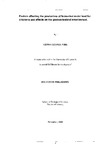Factors affecting the production of fermented moist feed for chickens and effects on the gastrointestinal environment
| dc.contributor.author | Niba, Aziwo Tatanja | |
| dc.contributor.other | School of Biological and Marine Sciences | en_US |
| dc.date.accessioned | 2013-10-18T10:30:27Z | |
| dc.date.available | 2013-10-18T10:30:27Z | |
| dc.date.issued | 2008 | |
| dc.date.issued | 2008 | |
| dc.identifier | NOT AVAILABLE | en_US |
| dc.identifier.uri | http://hdl.handle.net/10026.1/2222 | |
| dc.description | Merged with duplicate record 10026.1/611 on 07.03.2017 by CS (TIS) | |
| dc.description.abstract |
Fermented feed technology is a biosafe method of feed preparation and fermentation improves feed quality. Factors affecting lactic acid production in fen-nented moist feed for chickens and the influence of fermented feed on the gastrointestinal environment of chickens were investigated. Water quality was observed to affect lactic acid production in fermentation of cereals (maize, sorghum, wheat and barley). The presence of calcium carbonate in the fermentation mixture significantly (P<0.01) reduced lactic acid production from maize, sorghum and wheat. Grain particle size did not significantly affect feed fermentation as biosafe concentrations of lactic acid (>150mmol/L) were obtained from fermentation of coarse grain particle sizes. Differences in polyphenols content of red and white sorghum varieties did not have a significant effect on 24-hour lactic acid production from sorghum for any LAB used (Lactobacillus plantarum (SLP), Lactobacillus farciminis, Pediococcus acidilactici (PA I) L. plantarum NCIMB 41229). In vivo experiments on the application of Lactobacillus plantarum NCIMB 41229 (of porcine origin) as a feed fen-nenter and in water for chickens showed a marked reduction of Salmonella colonisation between dosing through fen-nented feed and through water. Dosing through water had a modest response while dosing through fen-nented feed had a significant effect on the birds' resistance to Salmonella colonisation (40% vs 75% of birds resistant). Molecular-based analysis of gut microbial species diversity showed that banding patterns for fermented feed treatments were closely related (>60%). The application of Lactobacillus plantarum NCIMB 41229 to chickens through fermented feed could be a better way of controlling Salmonella in chickens than through water. Lactobacillus plantarum NCIMB 41229 could be used as effective moculant for the production of fermented moist feed for chickens. Keywords: Cereals; chickens; fermented moist feeds; gastrointestinal environment; lactic acid bacteria. | en_US |
| dc.language.iso | en | en_US |
| dc.publisher | University of Plymouth | en_US |
| dc.subject | Cereals; | en_US |
| dc.subject | Chickens; | en_US |
| dc.subject | Fermented moist feeds; | en_US |
| dc.subject | gastrointestinal environment; | en_US |
| dc.subject | Lactic acid bacteria | en_US |
| dc.title | Factors affecting the production of fermented moist feed for chickens and effects on the gastrointestinal environment | en_US |
| dc.type | Thesis | |
| dc.identifier.doi | http://dx.doi.org/10.24382/3752 |
Files in this item
This item appears in the following Collection(s)
-
01 Research Theses Main Collection
Research Theses Main


